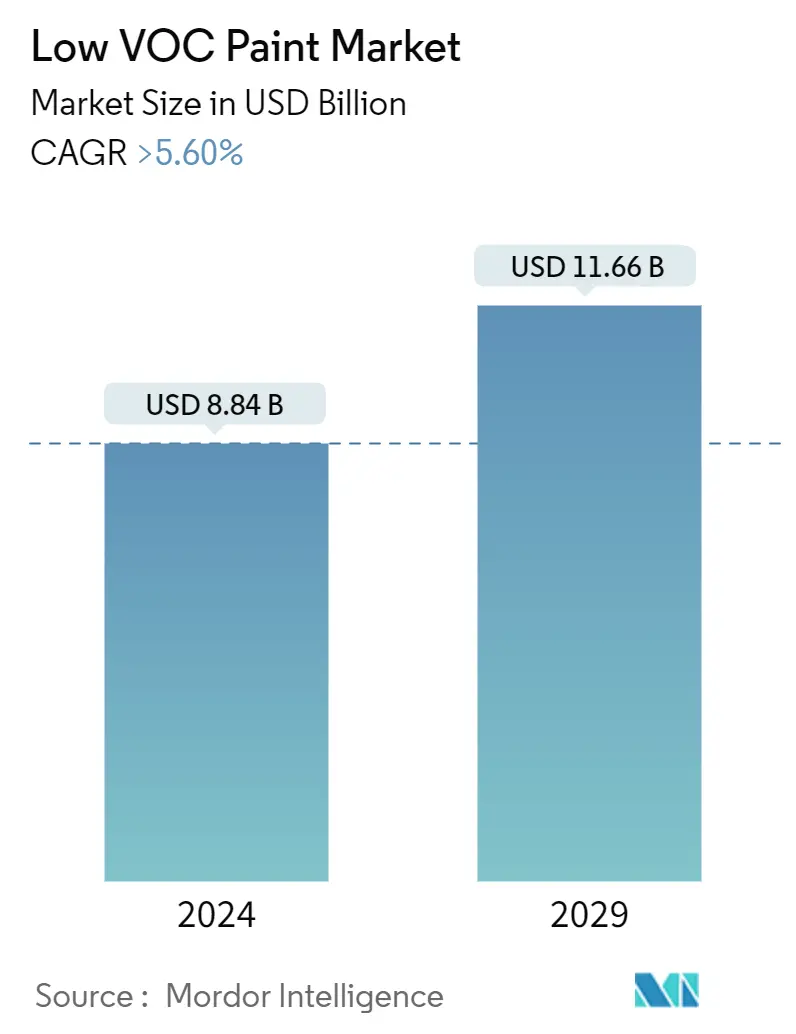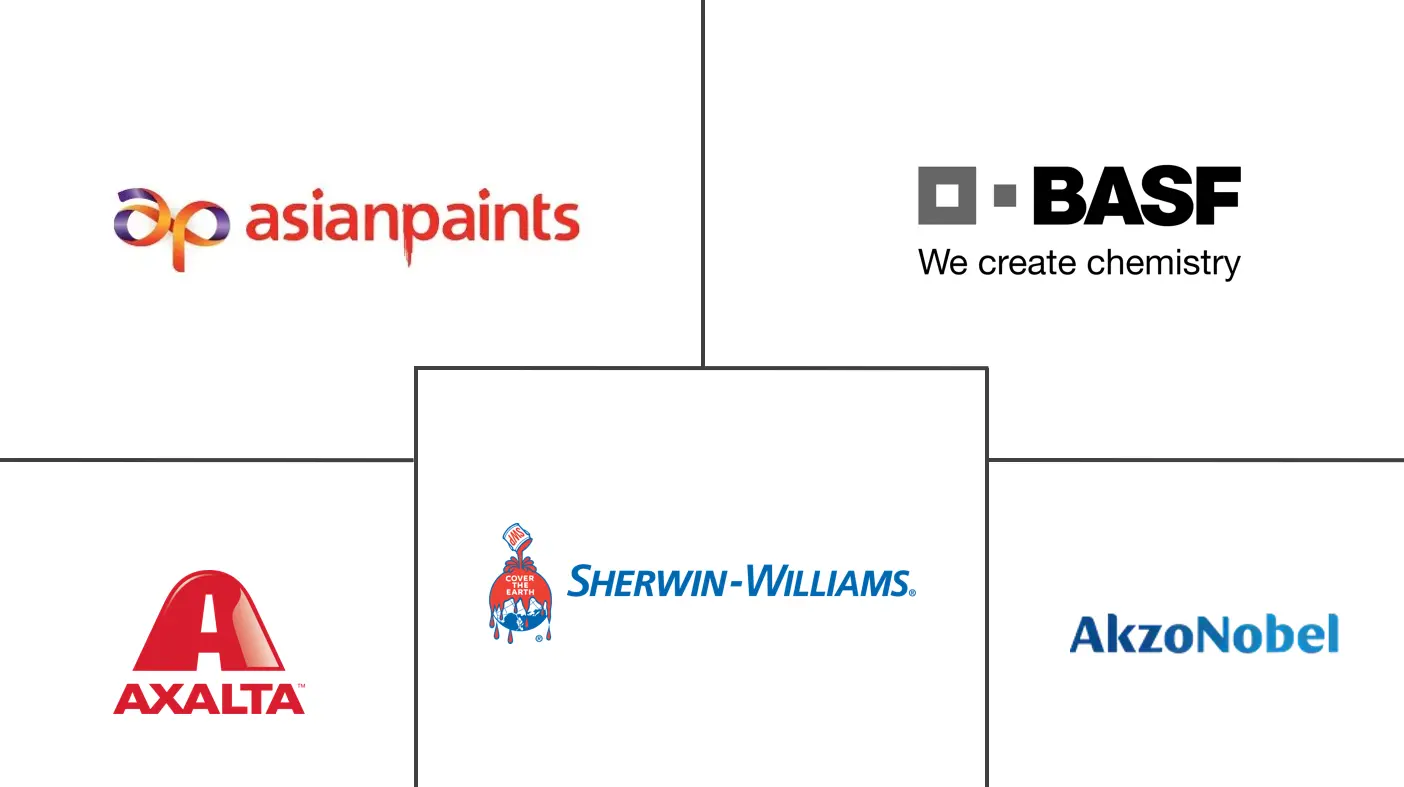Market Size of Low VOC Paint Industry

| Study Period | 2019 - 2029 |
| Market Size (2024) | USD 8.84 Billion |
| Market Size (2029) | USD 11.66 Billion |
| CAGR (2024 - 2029) | > 5.60 % |
| Fastest Growing Market | Asia Pacific |
| Largest Market | Asia Pacific |
| Market Concentration | Low |
Major Players
*Disclaimer: Major Players sorted in no particular order |
Low VOC Paint Market Analysis
The Low VOC Paint Market size is estimated at USD 8.84 billion in 2024, and is expected to reach USD 11.66 billion by 2029, growing at a CAGR of greater than 5.60% during the forecast period (2024-2029).
- The COVID-19 pandemic impacted the low VOC paint market in 2020 and 2021, driven by reduced economic and commercial activities coupled with declines in construction and industrial output. But the market recovered in recent years and is anticipated to grow over the period.
- The increasing awareness about the harmful effects of conventional paints, which is contrary to low VOC paints as they are eco-friendly and safe to use, is expected to drive the market's growth during the forecast period.
- On the other hand, the high cost of low VOC paint compared to conventional paint is expected to hinder the market's growth.
- The increasing construction of green buildings, shift toward eco-friendly chemicals, and recycling of low VOC paint will likely provide opportunities for the market studied during the forecast period.
- Asia-Pacific dominated the global market due to the high consumption of low-VOC paints from the architectural industry.
Low VOC Paint Industry Segmentation
Low VOC Paints contain fewer Volatile Organic Compounds (VOC) or solvents than conventional coatings. As VOCs evaporate and release hazardous chemicals into the air, adopting low-VOC products is preferable for improving air quality and helping to increase environmental sustainability.
The low VOC paint market is segmented by type, formulation type, application, and geography. By type, the market is segmented into low VOC, no or zero VOC, and natural. By formulation type, the market is segmented into water-borne, solvent-borne, and powder. By application, the market is segmented into architecture and decorative, general industrial, automotive OEM, automotive refinish, marine, consumer durables, and other applications (pharmaceuticals, electronics, etc.). The report also covers the market size and forecasts for the low VOC paint market for 15 countries across major regions.
For each segment, the market sizing and forecasts have been done based on value (USD).
| Type | |
| Low-VOC | |
| No or Zero VOC | |
| Natural |
| Formulation Type | |
| Water-borne | |
| Solvent-borne | |
| Powder |
| Application | |
| Architecture and Decorative | |
| General Industrial | |
| Automotive OEM | |
| Automotive Refinish | |
| Marine | |
| Consumer Durables | |
| Other Applications (Pharmaceuticals, Electronics, etc.) |
| Geography | |||||||
| |||||||
| |||||||
| |||||||
| |||||||
|
Low VOC Paint Market Size Summary
The low VOC paint market is poised for significant growth, driven by increasing awareness of the environmental and health impacts of traditional paints. As consumers and industries shift towards eco-friendly alternatives, low VOC paints are gaining traction, particularly in the architectural and decorative sectors. The market's expansion is supported by the rising construction of green buildings and the adoption of eco-friendly chemicals. However, the higher cost of low VOC paints compared to conventional options presents a challenge to market growth. The Asia-Pacific region leads the global market, fueled by substantial consumption in the architectural industry, with countries like China and India contributing to the demand through extensive residential and commercial construction activities.
The market landscape is characterized by a partial fragmentation, with key players such as Akzo Nobel N.V., Asian Paints, BASF SE, Axalta Coating Systems, LLC, and The Sherwin-Williams Company playing significant roles. Innovations in product offerings, such as air-purifying paints and waterborne binders with low VOC levels, are enhancing the market's appeal. The automotive sector also presents a substantial opportunity for low VOC paints, particularly in regions with robust automotive production bases like China. As governments and industries continue to prioritize sustainability, the demand for low VOC paints is expected to rise, offering promising growth prospects during the forecast period.
Low VOC Paint Market Size - Table of Contents
-
1. MARKET DYNAMICS
-
1.1 Drivers
-
1.1.1 Increasing Awareness about Harmful Effects of Conventional Paint
-
1.1.2 increasing Demand in Architectural and Decorative Industry
-
1.1.3 Other Drivers
-
-
1.2 Restraints
-
1.2.1 High Cost in Comparison to Conventional Paint
-
1.2.2 Other Restraints
-
-
1.3 Industry Value Chain Analysis
-
1.4 Porter's Five Forces Analysis
-
1.4.1 Bargaining Power of Suppliers
-
1.4.2 Bargaining Power of Buyers
-
1.4.3 Threat of New Entrants
-
1.4.4 Threat of Substitute Products and Services
-
1.4.5 Degree of Competition
-
-
-
2. MARKET SEGMENTATION (Market Size in Value)
-
2.1 Type
-
2.1.1 Low-VOC
-
2.1.2 No or Zero VOC
-
2.1.3 Natural
-
-
2.2 Formulation Type
-
2.2.1 Water-borne
-
2.2.2 Solvent-borne
-
2.2.3 Powder
-
-
2.3 Application
-
2.3.1 Architecture and Decorative
-
2.3.2 General Industrial
-
2.3.3 Automotive OEM
-
2.3.4 Automotive Refinish
-
2.3.5 Marine
-
2.3.6 Consumer Durables
-
2.3.7 Other Applications (Pharmaceuticals, Electronics, etc.)
-
-
2.4 Geography
-
2.4.1 Asia-Pacific
-
2.4.1.1 China
-
2.4.1.2 India
-
2.4.1.3 Japan
-
2.4.1.4 South Korea
-
2.4.1.5 Rest of Asia-Pacific
-
-
2.4.2 North America
-
2.4.2.1 United States
-
2.4.2.2 Canada
-
2.4.2.3 Mexico
-
-
2.4.3 Europe
-
2.4.3.1 Germany
-
2.4.3.2 United Kingdom
-
2.4.3.3 France
-
2.4.3.4 Italy
-
2.4.3.5 Rest of Europe
-
-
2.4.4 South America
-
2.4.4.1 Brazil
-
2.4.4.2 Argentina
-
2.4.4.3 Rest of South America
-
-
2.4.5 Middle-East and Africa
-
2.4.5.1 Saudi Arabia
-
2.4.5.2 South Africa
-
2.4.5.3 Rest of Middle-East and Africa
-
-
-
Low VOC Paint Market Size FAQs
How big is the Low VOC Paint Market?
The Low VOC Paint Market size is expected to reach USD 8.84 billion in 2024 and grow at a CAGR of greater than 5.60% to reach USD 11.66 billion by 2029.
What is the current Low VOC Paint Market size?
In 2024, the Low VOC Paint Market size is expected to reach USD 8.84 billion.

